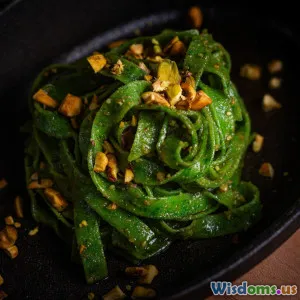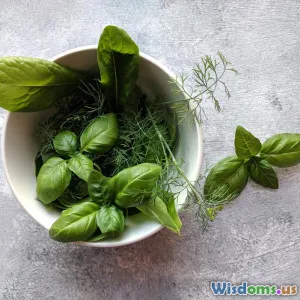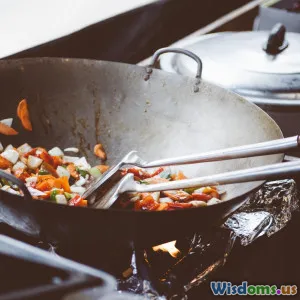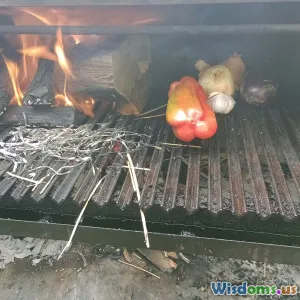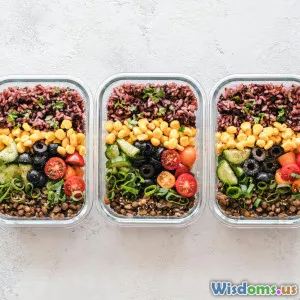
StepbyStep Guide to Sustainable Meal Planning With Local Foods
8 min read A comprehensive step-by-step guide to creating sustainable meal plans using local foods to boost health and support the environment. (0 Reviews)
Step-by-Step Guide to Sustainable Meal Planning With Local Foods
Introduction: Why Choose Sustainable Meal Planning with Local Foods?
Imagine a world where your weekly meals not only nourish your body but also honor the planet and your local community. Sustainable meal planning with local foods promises exactly that—a delicious way to reduce environmental impact, support farmers in your area, and enjoy fresher, more nutrient-rich ingredients.
The average meal in many developed countries travels over 1,500 miles from farm to table, significantly increasing carbon emissions and food waste. By shifting to local, seasonal choices, you reduce that "food mile" footprint, promote biodiversity, and often spend less. According to a study by the University of California, locally grown produce can have up to 50% lower carbon emissions than those imported from abroad.
This guide will take you through practical steps to successfully integrate local foods into your meal planning, making sustainability effortless and rewarding.
Body
1. Understanding Sustainable Meal Planning
Sustainable meal planning transcends simply eating healthily. It involves:
- Supporting agricultural practices that protect the environment.
- Prioritizing foods that are in season and locally grown.
- Minimizing packaging and food waste.
- Reducing reliance on processed and heavily transported foods.
This holistic approach benefits economics, ecology, and your health concurrently.
2. Know Your Local Food Sources
Identifying where and how to buy local staples is the first critical step.
-
Farmers’ Markets: Most cities host weekly farmers’ markets where local producers sell fresh, seasonal fruits and vegetables, homemade dairy products, and sometimes meats.
-
Community Supported Agriculture (CSA): Joining a CSA means subscribing to receive weekly boxes of fresh produce directly from a local farm. It supports farmer stability and guarantees freshness.
-
Local Grocers & Co-ops: Many grocery stores now offer dedicated local sections; cooperatives often champion local farmers and sustainable products.
-
Foraging & Home Gardening: When applicable, growing your own herbs or vegetables or responsibly foraging local wild edibles can be sustainable and cost-effective.
Example:
Marika, a Portland resident, reduced her carbon footprint by 30% simply by switching to a weekly CSA box and tweaking her recipes around its contents. This not only diversified her diet but connected her with the food’s origins.
3. Shop Seasonally to Maximize Sustainability
Eating seasonally means consuming fruits and vegetables that are naturally ripe and harvested during a particular season. This reduces the need for artificial ripening, long-term cold storage, or out-of-season imports.
- Use seasonal produce guides available online or community centers.
- Create meal plans based on in-season crops; for example, summer offers tomatoes, corn, and peaches, while winter focuses on root vegetables and hearty greens.
Data Insight:
A report by the Environmental Working Group found eating seasonally reduces water use and energy consumption by almost 20% compared to an out-of-season diet.
4. Plan Your Meals: Steps to a Sustainable Weekly Menu
Planning ahead is crucial for reducing food waste and optimizing local buys.
Step 1: Inventory Your Kitchen
Before shopping, list what you have—this prevents buying duplicates and declutters your fridge.
Step 2: Choose a Focal Seasonal Ingredient
Pick a local vegetable or fruit grown abundantly this week and build meals around it. For example, a CSA box summer week might include an abundance of zucchini; plan stir-fries, roasted veggie sides, or zucchini bread.
Step 3: Mix and Match Protein Sources
Opt for sustainably raised local proteins such as pasture-raised chicken, wild-caught fish, or locally sourced legumes and nuts.
Step 4: Prepare a Shopping List Based on Planned Meals
Include only what you need for your planned recipes.
Step 5: Commit to Flexible Recipes
Adapt your meals if an unexpected seasonal vegetable pops up at your market.
5. Minimize Food Waste and Packaging
Discarding uneaten food negates many sustainability efforts. Try these tips:
- Use all parts of a vegetable (e.g., beet greens make great pesto).
- Store produce properly to extend freshness.
- Compost organic waste to return nutrients to the soil.
Skipping heavily packaged goods also reduces landfill waste and exposure to harmful materials.
6. Practical Recipes Highlighting Local and Seasonal Foods
Roasted Root Vegetable Salad
- Ingredients: Local carrots, beets, parsnips, olive oil, fresh rosemary, local goat cheese
- Why it’s sustainable: using seasonal root vegetables that store well and are locally grown.
Summer Veggie Stir-Fry with Local Tofu
- Ingredients: Seasonal zucchini, bell peppers, local tofu, garlic, ginger
- Benefits: Quick to prepare, highlights fresh local produce, plant-based protein reduces carbon footprint.
Foraged Herb and Wild Berry Salad
- Ingredients: Mixed greens from garden, wild berry mix, pine nuts, a honey-lemon dressing
- Added value: Connects the meal with your specific local ecology.
7. Real-World Insight: Success Stories
In Boulder, Colorado, a city-backed initiative encouraging residents to buy local resulted in a 15% increase in farmers' market attendance over two years and measurable reductions in neighborhood food-related waste. They showcased monthly meal planners highlighting seasonal items to consumers.
Conclusion: Taking the First Step Towards Sustainable Eating
Sustainable meal planning with local foods is not just a trend—it’s a feasible lifestyle change with lasting benefits for your health, wallet, and the earth. By understanding your local food environment, embracing seasonality, planning thoughtfully, and committing to minimizing waste, you become an active agent of change.
Start small: visit a nearby farmers’ market this weekend or subscribe to a CSA box. Allow your meal planning to evolve naturally with the rhythms of your region’s harvests. The planet—and your palate—will thank you.
Remember, sustainable eating is a journey, and each meal is an opportunity to make a positive impact. Happy local cooking!
References:
- University of California, 'Food Miles and Carbon Emissions' Report, 2020
- Environmental Working Group, 'Seasonality and Food Sustainability Study,' 2019
- Boulder City Local Food Initiative, Progress Report, 2022
Rate the Post
User Reviews
Popular Posts












